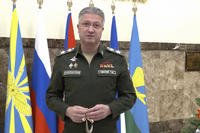Marine Corps Commandant Gen. James Conway has promised that the controversial MV-22 Osprey will be flying in Afghanistan by the end of the year. He recently told a Washington audience that the Osprey, “has gone from a wounded duck to a poster child in terms of what aircraft with that leap-ahead technology can do.”
Not so, according to some lawmakers on the Hill who are calling for an outright end to V-22 production, claiming the tilt-rotor suffers from low readiness rates and lacks the maneuverability to evade hostile ground fire. One of the plane’s more vocal critics, Rep. Edolphus Towns (D-NY), chairman of the House Oversight and Government Reform Committee, said at a hearing last month that the plane is a failure and “its time to put the Osprey out of its misery.”
Osprey critics brandished a June GAO report that cited maintenance and reliability problems and questioned the plane’s ability to fly in “high-threat” environments. Setting aside for the moment the fact that barring extensive air-defense suppression by electronic warfare and strike aircraft, the military doesn’t typically send aircraft into high threat environments, I'm not sure Afghanistan is a high threat environment. I have heard commanders there say that the Taliban has beefed up its air defenses and that it may now have some newer generation shoulder-fired missiles, or MANPADS. High-threat or not, at a minimum, then, the Osprey should have the ability to survive against occasional MANPADS.
Marine sources confirmed to me that a Marine Osprey flying in Iraq successfully evaded a MANPAD, so I have to question GAO’s statement about Osprey vulnerability. One of the reasons GAO gave, was that the Osprey lacks an onboard defensive gun to hose down hot landing zones. Now, the Marines are fitting machine guns to the plane to give it some defensive capability, so that should help out in that area.
GAO also said: “The V-22 had maneuvering limits that restrict its ability to perform defensive maneuvers.” The wording in that sentence sounded odd. Is GAO saying the plane cannot perform defensive maneuvers or is there some regulation against it performing certain maneuvers? Not the same thing.
I asked a Marine officer who is very knowledgeable on the subject of V-22 survivability about the GAO’s findings. The officer requested anonymity so as to speak frankly about a politically charged issue and I thought it important to at least present another voice in the Osprey debate.
The officer said the maneuvering limits in the official Naval Air Training and Operating Procedures Standardization were set by engineers who did not carry out the full battery of tests on the plane because of money shortages during the operational test phase. The Osprey’s troubled developmental history meant the focus was on keeping the plane in the air, not on testing it in battlefield situations.
As currently written, those NATOPS forbid pilots from pulling back on the control stick and pitching the plane’s nose up more than 20 degrees in the vertical axis. It’s a simple defensive maneuver and one the plane is more than capable of performing. Stalling is not a factor, the officer said, as the plane is moving much too fast to stall.
The importance of MV-22 pilots being allowed to perform the maneuver, which NATOPS limits say they cannot even practice, is that it is an effective way to evade an anti-aircraft missile. “Every tactical pilot knows that success in defensive maneuver requires two elements: expendables plus maneuver… you’re throwing out a decoy and then you get away from your decoy, you displace yourself in as many axes as you can to provide the biggest solution problem for the missile,” the officer said.
Once a MANPAD missile is decoyed by a flare, and the aircraft successfully evades, contrary to the movies, the missile will not reacquire the aircraft. The missile will fly straight through the decoy flare, continuing along its same flight path until the rocket motor burns out, which happens within a matter of seconds. “You can’t just hang out on the same flight path when the missile was shot at you,” the officer said, “when the missile flies through the last flare, and at the end of that last flare there’s an airplane, it’s going to hit you.”
The seeker on most MANPADS has a very limited field of view, no more than about 5 degrees off the missile’s centerline. When the Osprey pilot hears a missile alert tone, the pilot only has to displace the aircraft 300 feet to be out of the seeker head field of view when it passes the last decoy flare, the officer said. Pulling back on the stick and pitching the nose up 40 degrees for about three seconds will do that. The pilot must then get the nose down and pick up speed so as to do the maneuver again and again until the plane is out of the threat zone. That maneuver was shown to be very effective at evading the most advanced missiles in thousands of test simulations.
The V-22 flies like a fixed wing airplane, it just takes off and lands like a helicopter. Most Marine Osprey pilots are former helicopter pilots. They fly the plane like a helicopter, the officer said, which too often means flying straight and level through a threat area and relying on onboard defensive systems, electronic missile warning and decoy flares, to protect the aircraft from missiles. The danger, the officer said, is that because of the NATOPS limits, Marine pilots are not practicing simple defensive maneuvers that are well within the plane’s abilities.








